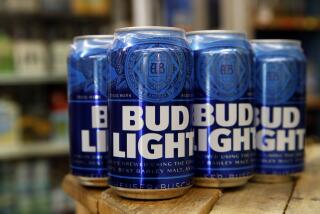Beer Industry Joins Critics of Seagram Ads
- Share via
SAN FRANCISCO — The U.S. beer industry is planning to join domestic vintners in criticism of the Seagram advertising campaign, which argues that average servings of beer, wine and spirits contain virtually the same amounts of alcohol.
Donald B. Shea, president of the U.S. Brewers Assn., called Seagram’s widely advertised “drink-is-a-drink-is-a-drink” campaign “misguided and inappropriate . . . the information is wrong . . . fallacious.”
Shea said in an interview that the entire beer industry, including brewers and wholesalers, will join the wine industry “to prove that a drink is not a drink,” even though chemical analysis might show certain amounts of the three beverages would produce the same amounts of alcohol.
Industry’s Message
The wine industry’s message, in general, is that the ads ignore the body’s absorption rate of alcohol in wine, beer and spirits, and that it is highest and fastest when consumed as hard liquor.
Shea said the beer industry plans “to contact the appropriate regulatory agencies to correct what we believe is misinformation . . . to legislators and regulators alike.”
For weeks Winegrowers of California--a quasi-public agency regulated under a state-administered marketing order--has been taking swipes at the Seagram campaign, calling it “dangerously oversimplified . . . erroneous.”
Robert Hartzell, spokesman for the group, said the Seagram campaign “ignores the fact that wine, beer and liquor produce significantly different rates of absorption--blood alcohol levels--and resulting intoxication when abused. This omission is dangerously misleading . . . .”
In a plea to the federal Bureau of Alcohol, Tobacco and Firearms, Hartzell said, “There is a vast amount of medical evidence that indicates the alcohol in wine and beer is absorbed into the bloodstream at a significantly slower rate (than spirits) and that much higher peaks of blood alcohol are achieved with liquor whether a person has eaten or not.”
Both wine and beer industry representatives said the campaign is actually meant to bolster liquor sales for Seagram.
More to Read
Inside the business of entertainment
The Wide Shot brings you news, analysis and insights on everything from streaming wars to production — and what it all means for the future.
You may occasionally receive promotional content from the Los Angeles Times.







